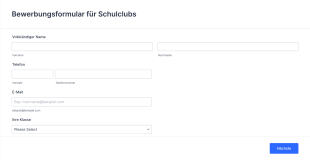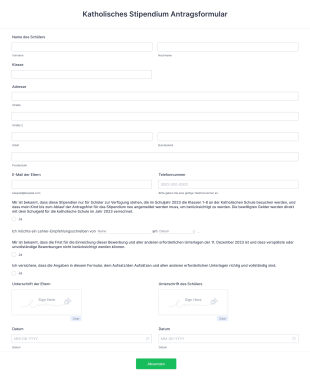Stipendienantragsformulare
Über Stipendienantragsformulare
Bewerbungsformulare für Stipendien sind ein unverzichtbares Tool für Studierende, die finanzielle Unterstützung für ihre Ausbildung suchen. Diese Formulare werden von Bildungseinrichtungen, gemeinnützigen Organisationen, Stiftungen und Behörden verwendet, um detaillierte Informationen von Bewerber:innen zu erfassen, beispielsweise zu ihren akademischen Leistungen, ihrer finanziellen Bedürftigkeit, ihrem außerschulischen Engagement und ihren persönlichen Statements. Sie optimieren den Prozess der Bewerberbewertung und stellen sicher, dass alle erforderlichen Daten in standardisierter und organisierter Form erfasst werden. Sie kommen in einer Vielzahl von Anwendungsfällen zum Einsatz, darunter Stipendienprogramme für Bachelor- und Masterstudierende, spezielle Auszeichnungen für Sport, Kunst oder gemeinnützige Arbeit sowie Stipendien für bestimmte Bevölkerungsgruppen oder Studienfächer.
Mit Jotform erstellen, passen und verwalten Sie Stipendienbewerbungsformulare online — ganz ohne Programmierkenntnisse. Gestalten Sie im intuitiven Drag-and-Drop-Generator Formulare nach Ihren Anforderungen, fügen Sie bedingte Logik hinzu und integrieren Sie Zahlungsportale für Bewerbungsgebühren. Ihre Antworten werden automatisch in Jotform Tabellen gespeichert und organisiert, sodass Sie Bewerbungen einfach prüfen, filtern und verwalten können. Optimieren Sie so Ihren Stipendienbewerbungsprozess, verbessern Sie die Datengenauigkeit und bieten Sie Ihren Bewerbern eine hervorragende Erfahrung.
Anwendungsbeispiele für Stipendienantragsformulare
Stipendienantragsformulare dienen verschiedenen Zwecken und können an die Bedürfnisse unterschiedlicher Organisationen und Bewerbergruppen angepasst werden. Hier erfahren Sie, wie sie verwendet werden können, wer sie nutzen kann und wie ihr Inhalt variieren kann:
1. Mögliche Anwendungsfälle:
- Stipendienprogramme von Universitäten oder Hochschulen für neue oder derzeitige Studierende
- Zuschüsse von gemeinnützigen Organisationen oder Stiftungen für bestimmte Zwecke oder Bevölkerungsgruppen (z. B. Studierende der ersten Generation, MINT-Studierende)
- Sport- oder Kunststipendien, für die Portfolios oder Leistungsnachweise erforderlich sind
- Von Unternehmen gesponserte Stipendien für Kinder von Mitarbeitern oder Gemeindemitgliedern
- Staatlich finanzierte Bildungszuschüsse
2. Lösungsansätze:
- Standardisiert die Erfassung von Bewerberdaten für eine faire und effiziente Bewertung
- Reduziert Schreibarbeit und manuelle Dateneingabe und minimiert Fehler
- Ermöglicht die einfache Nachverfolgung und Verwaltung großer Mengen von Bewerbungen
- Erleichtert die Kommunikation mit Bewerbern durch automatisierte Benachrichtigungen
3. Mögliche Anwender und Nutzer:
- Bildungseinrichtungen (Zulassungs- und Finanzhilfebüros)
- Gemeinnützige Organisationen und Stiftungen
- HR- oder CSR-Abteilungen von Unternehmen
- Behörden
- Studierende und ihre Familien
4. Unterschiede in der Erstellung:
- Für akademische Stipendien sind möglicherweise Zeugnisse, der Notendurchschnitt und Empfehlungsschreiben erforderlich
- Bedarfsorientierte Stipendien können finanzielle Angaben und unterstützende Dokumente erfordern
- Talentbasierte Stipendien können die Einreichung von Portfolios, Bewerbungsvideos oder Projektbeispielen erfordern
- Für demografiespezifische Stipendien kann ein Nachweis der Berechtigung erforderlich sein (z. B. Wohnsitz, Minderheitenstatus)
- Einige Formulare können Essayfragen enthalten, während andere sich auf Checklisten oder kurze Antworten konzentrieren
Zusammenfassend lässt sich sagen, dass Stipendienantragsformulare auf eine Vielzahl von Szenarien zugeschnitten werden können, sodass Organisationen die richtigen Informationen für ihre individuellen Auswahlkriterien erfassen können.
So erstellen Sie ein Stipendienantragsformular
Das Erstellen eines Stipendienantragsformulars mit Jotform ist ein unkomplizierter Vorgang, mit dem Sie alle erforderlichen Informationen von Bewerbern effizient und sicher erfassen können. Ganz gleich, ob Sie ein Universitätsstipendium, eine gemeinnützige Förderung oder eine Unternehmensauszeichnung verwalten – mit den flexiblen Tools von Jotform können Sie ganz einfach ein Formular gestalten, das Ihren spezifischen Anforderungen entspricht.
Um ein Stipendienantragsformular zu erstellen, gehen Sie bitte wie folgt vor:
1. Starten Sie Ihr Formular:
- Melden Sie sich bei Ihrem Jotform-Konto an und klicken Sie auf Ihrer Seite „Mein Workspace“ auf „Erstellen“.
- Wählen Sie „Formular“ und entscheiden Sie, ob Sie ganz neu beginnen oder eine der über 10.000 Vorlagen von Jotform verwenden möchten. Für Stipendienanträge finden Sie möglicherweise relevante Vorlagen, die an Ihre Anforderungen angepasst werden können.
2. Wählen Sie ein Layout:
- Wählen Sie zwischen dem klassischen Formular (alle Fragen auf einer Seite) und dem Kartenformular (eine Frage pro Seite). Für längere Bewerbungen bietet das Kartenformular eine übersichtlichere Anleitung.
3. Wesentliche Felder hinzufügen:
- Verwenden Sie den Drag-and-Drop Formulargenerator, um Felder hinzuzufügen, wie:
- Persönliche Daten (Name, Kontaktdaten, Geburtsdatum)
- Akademischer Hintergrund (Schule, Notendurchschnitt, Zeugnisse hochladen)
- Finanzielle Informationen (Haushaltseinkommen, Belege)
- Außerschulische Aktivitäten und Erfolge
- Felder für Aufsätze oder persönliche Erklärungen (langer Text)
- Felder für den Datei-Upload von Empfehlungsschreiben oder Portfolios
- Checkboxen oder Dropdown-Menüs zur Überprüfung der Berechtigung für demografiespezifische Stipendien
4. Formular anpassen:
- Klicken Sie auf das Symbol Farbroller, um den Formulardesigner zu öffnen.
- Passen Sie Farben, Schriftarten und Layout an das Branding Ihrer Organisation an.
- Fügen Sie das Logo Ihrer Organisation hinzu und passen Sie die URL des Formulars an, um einen professionellen Eindruck zu vermitteln.
5. Bedingte Logik einrichten:
- Verwenden Sie bedingte Logik, um Felder basierend auf den Antworten der Bewerber ein- oder auszublenden (z. B. Finanzfragen nur für bedarfsorientierte Stipendien anzeigen).
6. Konfigurieren Sie E-Mail-Benachrichtigungen:
- Richten Sie Autoresponder-E-Mails ein, um den Eingang von Bewerbungen zu bestätigen und Ihr Team über neue Antworten zu informieren.
7. Veröffentlichen und teilen:
- Klicken Sie auf „Veröffentlichen“, um den Formularlink zu kopieren und per E-Mail, über Ihre Website oder über Social Media zu teilen.
8. Testen Sie Ihr Formular:
- Verwenden Sie die Vorschau, um das Formular zu testen und sicherzustellen, dass alle Felder und die Logik wie vorgesehen funktionieren.
9. Antworten verwalten:
- Greifen Sie auf Antworten in Jotform Tabellen zu, wo Sie Bewerbungen effizient filtern, sortieren und überprüfen können.
Wenn Sie diese Schritte befolgen, können Sie ein umfassendes Stipendienantragsformular erstellen, das den Bewerbungsprozess optimiert, die Richtigkeit der Daten gewährleistet und sowohl Bewerbern als auch Prüfern eine positive Erfahrung bietet.
Häufig gestellte Fragen
1. Was ist ein Stipendienantragsformular?
Ein Stipendienantragsformular ist ein Dokument oder Online-Formular, das von Organisationen verwendet wird, um Informationen von Studierenden zu sammeln, die sich um finanzielle Unterstützung oder Bildungszuschüsse bewerben.
2. Warum sind Stipendienantragsformulare wichtig?
Sie standardisieren den Bewerbungsprozess, stellen sicher, dass alle erforderlichen Informationen erfasst werden, und unterstützen Unternehmen dabei, Bewerber fair und effizient zu bewerten.
3. Welche Angaben sind in der Regel in einem Stipendienantragsformular erforderlich?
Zu den üblichen Angaben gehören persönliche Daten, akademische Leistungen, finanzielle Informationen, außerschulische Aktivitäten, Aufsätze und unterstützende Dokumente wie Zeugnisse oder Empfehlungsschreiben.
4. Gibt es verschiedene Arten von Stipendienantragsformularen?
Ja, die Formulare können je nach Zweck des Stipendiums variieren, beispielsweise je nach akademischen Leistungen, finanzieller Bedürftigkeit, sportlichem oder künstlerischem Talent oder demografischen Kriterien.
5. Wer kann Stipendienantragsformulare verwenden?
Bildungseinrichtungen, gemeinnützige Organisationen, Stiftungen, Unternehmen, Behörden und Studierende, die Stipendien suchen, können diese Formulare verwenden.
6. Wie wird die Privatsphäre der Bewerber in Stipendienantragsformularen geschützt?
Seriöse Plattformen wie Jotform verwenden sichere Datenspeicherung, Verschlüsselung und Datenschutzkontrollen, um sensible Bewerberdaten zu schützen.
7. Können Stipendienantragsformulare Datei-Uploads enthalten?
Ja, viele Formulare ermöglichen es Bewerbern, Dokumente wie Zeugnisse, Aufsätze, Portfolios oder Empfehlungsschreiben direkt im Formular hochzuladen.
8. Wie werden Stipendienanträge von Organisationen geprüft und verwaltet?
Die Antworten werden in der Regel in einer Datenbank oder Tabelle organisiert, sodass die Prüfer die Bewerbungen effizient filtern, sortieren und bewerten können, häufig mit integrierten Tools für die Kommunikation und Statusverfolgung.






